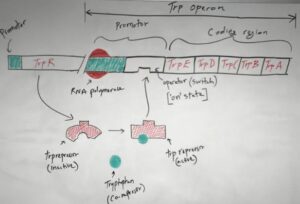Back to: MICROBIOLOGY 200 LEVEL
Welcome to class!
Welcome, brilliant mind! It’s always a joy having you here. You’ve been growing your microbiology knowledge with such grace and consistency, and today’s topic is one that explains how genes can behave almost like a well-organised team of workers. We’re talking about the Operon Model, and you’ll see how smart and efficient bacteria are when it comes to saving energy and controlling gene expression — just like how a smart Nigerian household manages NEPA light!
Operon Model (Lac Operon, Trp Operon)
Imagine a compound with several tenants. Everyone shares the same borehole water system, and the water pump only comes on when the tank is low. Once it’s full, the pump stops to save electricity. That’s exactly how bacteria control which genes to switch on or off depending on what they need at the moment.

This organised system of controlling multiple genes using a single switch is what we call an operon. Operons are commonly found in prokaryotes (like bacteria), and they help them control several genes all at once for efficiency.
Let’s look at two famous examples: the lac operon and the trp operon.
Lac Operon (Inducible Operon)
Found in E. coli, it helps the bacteria digest lactose, a type of sugar.
The operon has three main parts:
Promoter – where RNA polymerase binds to start transcription.
Operator – the switch that can be turned on or off.
Structural genes – the actual genes needed to digest lactose.
When there is no lactose, a repressor protein sits on the operator and blocks transcription (like locking a door).
When lactose is present, it binds to the repressor, removes it, and allows the structural genes to be read and used to make enzymes that break down lactose.
This is an inducible operon because it stays off until lactose is present — like turning on the generator only when NEPA takes light.
Trp Operon (Repressible Operon)
This operon controls the production of tryptophan, an amino acid.
It is usually on and working, producing tryptophan.
But when tryptophan is already enough in the cell, it acts like a co-repressor and shuts down the operon by helping the repressor bind to the operator.
This is a repressible operon — always active until there’s too much product, then it switches off to save resources.

Think of the lac operon like boiling rice only when you have rice in the house. You don’t light the stove until there’s rice to cook. That’s inducible.
Now think of the trp operon like fetching water into your drum. You keep filling until the drum is full, then you stop. That’s repressible.
Summary
- Operons are gene systems in prokaryotes that control multiple genes together.
- The lac operon is inducible — it turns on only when lactose is present.
- The trp operon is repressible — it stays on unless tryptophan is already enough.
- Both operons help bacteria save energy and work efficiently.
- Key components include promoters, operators, repressors, and structural genes.
Evaluation
- What is an operon?
- Explain how the lac operon works.
- What makes the trp operon a repressible system?
- Why do bacteria use operons instead of switching on genes one by one?
- In your own words, compare the lac and trp operons with relatable examples.
You’re becoming a true microbiology master! Every topic you’ve tackled brings you closer to deep understanding and excellence. Keep moving with this same fire and love for learning. With Afrilearn by your side, every lesson is a step toward greatness. I can’t wait to see you in the next class — stay sharp and stay curious!
